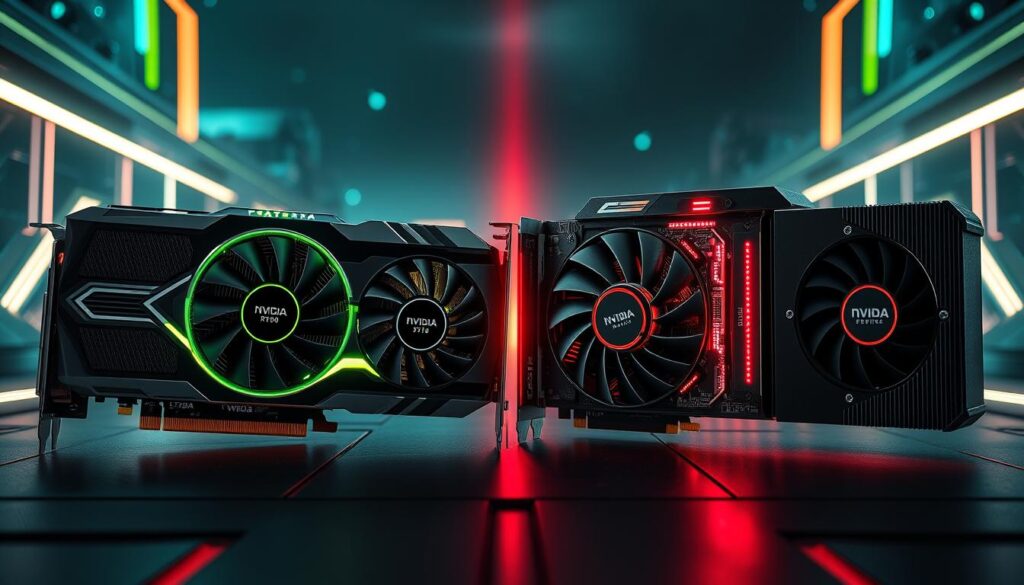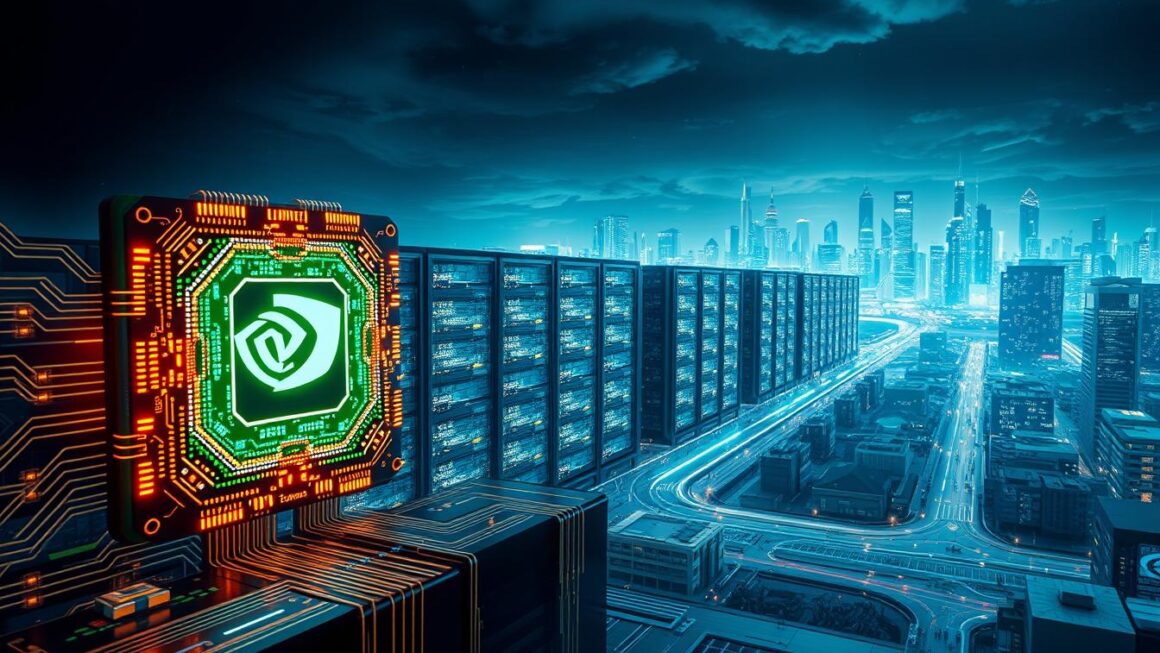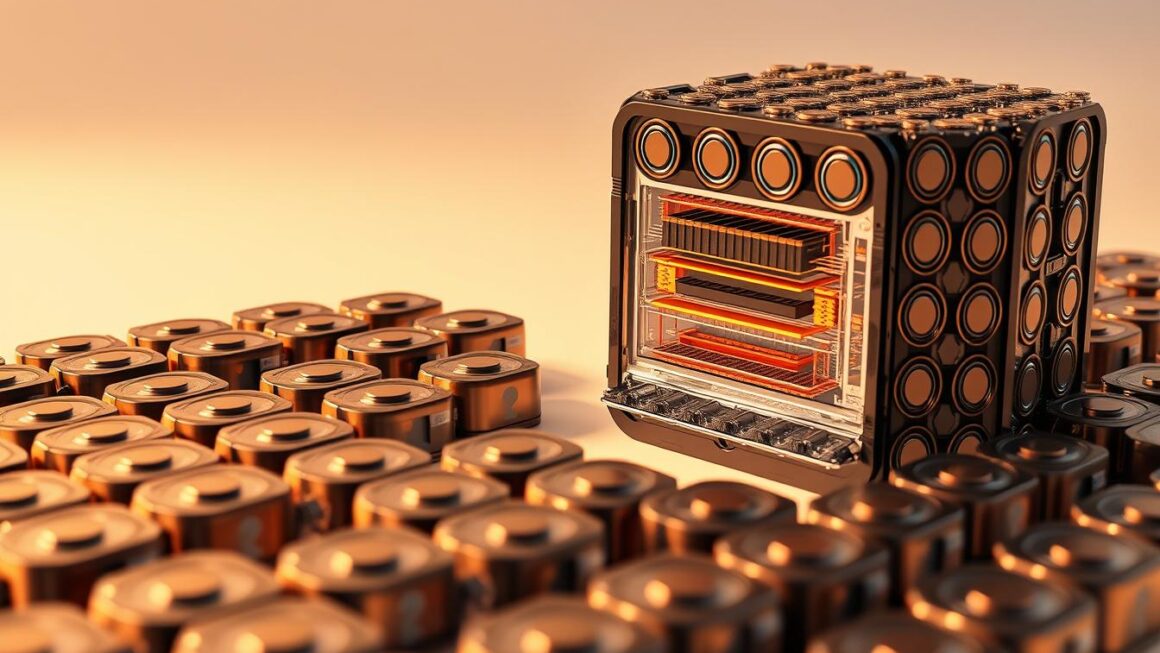The tech world is changing fast, thanks to NVIDIA’s big move towards AI. Their latest financial report showed a huge $39.3 billion in revenue. This is a 78% jump from last year, mainly because of their AI supercomputers and data center needs.
This big increase has raised eyebrows among gamers and tech fans. They’re worried if NVIDIA’s push for AI is hurting its gaming GPU innovation. We’ll dive into how NVIDIA’s AI focus affects its gaming GPUs and the tech market.
We’ll look at the clash between NVIDIA’s growing AI business and its loyal gaming fans. This will give us a peek into what’s next for gaming and AI tech.
The Evolution of NVIDIA: From Gaming Pioneer to AI Powerhouse
NVIDIA’s journey from a gaming GPU leader to an AI giant is filled with innovation. The company has grown a lot, adapting quickly to tech changes.
NVIDIA’s Gaming Roots and Early Innovations
NVIDIA started strong with its GeForce GPUs. These GPUs changed gaming by making graphics better. NVIDIA’s focus on quality helped it become a key player in gaming.
The Pivotal Shift Toward AI and Data Centers
NVIDIA moved towards AI and data centers, seeing big opportunities. This change was because of the need for more AI computing power. NVIDIA’s data center revenue soared to $115.2 billion in fiscal 2025, a huge jump.
Current Market Position and Financial Overview
Now, NVIDIA leads in gaming GPUs and AI/data centers. The company’s financial performance shows its success, with AI driving revenue growth. NVIDIA keeps innovating, staying at the top of the tech world.
The Current State of NVIDIA’s Gaming GPU Market
Looking at NVIDIA’s gaming GPU market, we see some important trends. The company has launched the GeForce RTX4000 series. This has caught the eye of gamers and tech fans.
RTX4000 Series: Performance vs. Price Analysis
The RTX4000 series has seen big performance boosts. Some models are up to 2x faster than their predecessors. But, the prices have also gone up a lot.
Gamers are worried about the value of these new GPUs. They feel the prices are too high.
The high-end models have seen big price increases. This has led to a lot of discussion. People are questioning the stagnation of gaming GPU innovation and the focus on AI.
Market Share and Competition from AMD and Intel
NVIDIA is leading the gaming GPU market, but AMD and Intel are catching up. AMD’s RDNA architecture has been popular. Intel’s Arc Graphics is also making waves.
Consumer Sentiment and Gamer Feedback
Gamers are watching NVIDIA closely. Some are worried about the company’s focus on AI and data center tech. Consumer sentiment is mixed.
Some gamers like the AI-enhanced gaming features like DLSS. Others feel gaming GPU innovation has slowed down.
The current state of NVIDIA’s gaming GPU market is complex. It involves tech advancements, market competition, and what gamers want.
NVIDIA’s AI Business: The New Golden Goose
NVIDIA’s AI efforts have made it a leader in the field. Its focus on AI has brought in new revenue streams. Now, its AI tech powers over 75% of the world’s top 500 supercomputers.
H100 and Data Center GPU Revenue Growth
The H100 GPU has boosted NVIDIA’s data center revenue. It’s designed for AI workloads and is used worldwide. This has led to a big increase in data center GPU sales for NVIDIA.
CUDA and Software Ecosystem Dominance
NVIDIA’s CUDA platform is key for AI development. It gives developers tools to build AI apps. CUDA’s dominance keeps NVIDIA at the top in AI.
AI Partnerships and Enterprise Solutions
NVIDIA has teamed up with big companies for AI solutions. These partnerships have grown NVIDIA’s AI customer base. They’ve also helped NVIDIA’s AI tech get used in many industries.
NVIDIA’s AI business is a big reason for its success. With a strong ecosystem and key partnerships, NVIDIA is set to lead in AI.
Is NVIDIA Just Farming Money? Stagnation in Gaming GPUs & Over-Reliance on AI
NVIDIA’s AI sector has grown fast, sparking debate on its focus and gaming GPU impact. As AI business thrives, worries about gaming GPU innovation slowing down grow.
Price-to-Performance Ratio Trends Over Generations
NVIDIA’s commitment to gaming GPUs is seen in its price-to-performance ratio over time. They’ve kept prices steady or lower while boosting performance. But, recent RTX 4000 series shows a big price jump.
This change worries gamers about NVIDIA’s latest value. The price-to-performance ratio is key for deciding to upgrade.
R&D Budget Allocation: Gaming vs. AI
NVIDIA’s R&D budget shift between gaming and AI is a big topic. While exact figures are unknown, AI seems to get more focus. This could slow down gaming GPU innovation.
The Diminishing Returns of Gaming GPU Innovation
The law of diminishing returns is a big worry in gaming GPU development. As GPUs get more powerful, making them even better gets harder and more expensive. NVIDIA’s latest GPUs, like the RTX 4090, are pushing limits but at a high cost.
It’s unclear if investing in gaming GPU innovation is worth it. As NVIDIA focuses more on AI, gamers and analysts will watch closely.
In summary, NVIDIA’s AI success raises big questions about its gaming GPU commitment. Finding a balance between AI and gaming will be key for NVIDIA’s future.
Technical Analysis: Gaming GPU Innovation Slowdown
NVIDIA’s Blackwell AI supercomputer made $11 billion in Q4. But, is this success hurting gaming GPU innovation?
GPU development is complex. It involves improving architecture, advancing manufacturing, and introducing new features. Let’s look into these areas to see why gaming GPU innovation might be slowing down.
Architecture Improvements Between Generations
NVIDIA has always pushed GPU architecture forward. But, the pace of these improvements has slowed. The latest GPUs are powerful, but they bring smaller changes than before. This could be because making more advanced GPUs is getting harder.
Manufacturing Process Advancements and Limitations
The semiconductor industry faces big challenges in manufacturing. As we hit the limits of Moore’s Law, making things smaller gets harder. NVIDIA has to find a balance between better performance and the costs of new manufacturing methods.
Feature Innovation: Ray Tracing, DLSS, and Beyond
NVIDIA has introduced cool features like ray tracing and DLSS. These have made games look and play better. But, they rely a lot on AI and deep learning. This shows how gaming and AI are becoming more connected in NVIDIA’s products.
In summary, NVIDIA is making GPU technology better, but innovation in gaming GPUs is slowing. This is due to challenges in architecture, manufacturing, and introducing new features.
The Financial Perspective: Following the Money
NVIDIA is growing its business in many ways. Its latest forecast shows $43.0 billion in revenue for Q1 FY2026. This is a 9% increase from the last quarter, showing strong financial health.
Revenue Breakdown: Gaming vs. Data Center
NVIDIA makes most of its money from gaming and data center sales. Gaming has always been a big part. But, the data center is growing fast, thanks to AI and cloud computing. Data center sales are now a big part of NVIDIA’s revenue growth.
Profit Margins Across Product Lines
NVIDIA’s profit margins vary by product line. The data center segment, with its AI chips like the H100, has higher margins than gaming GPUs. This difference shows where NVIDIA is focusing and how it affects its finances.
Investor Expectations and Stock Performance
NVIDIA’s stock is closely watched by investors. With strong revenue growth, investors are optimistic. The market is waiting to see if NVIDIA’s growth will keep going, or if it will slow down.
NVIDIA’s Strategic Decisions: Business Logic or Short-Sightedness?
NVIDIA’s move towards AI has sparked debate about its gaming GPU future. The company is pouring a lot of resources into AI. The tech world is watching to see if this is a smart move or a big risk.
The Business Case for AI Focus
NVIDIA’s AI focus makes good business sense. The company’s data center GPU sales have seen big revenue growth. Analysts think NVIDIA stock is a “Strong Buy,” with a price target of $700 per share.
Potential Risks of Neglecting the Gaming Market
But, there’s worry that NVIDIA’s focus on AI might slow down gaming GPU progress. Gamers are starting to think NVIDIA is just farming money from them without bringing new tech.
Balancing Innovation Across Product Lines
To avoid these problems, NVIDIA needs to balance its AI efforts with gaming innovation. By using its software and investing in both areas, NVIDIA can stay ahead in gaming and AI.
The Competitive Landscape: AMD, Intel, and New Challengers

NVIDIA is focusing on AI, giving AMD and Intel a chance to grow in the gaming GPU market. The competition is getting fierce, with big steps forward in both hardware and software.
AMD’s RDNA Architecture and Market Response
AMD’s RDNA architecture has made a big splash, matching NVIDIA’s gaming GPUs in performance. People are loving the value AMD’s graphics cards offer.
Intel’s Arc Graphics and Re-entry to the GPU Market
Intel is back in the GPU game with its Arc graphics series. The first reviews were a bit cool, but Intel is working hard to improve. They promise better performance and features soon.
Emerging Competitors in AI and Gaming Spaces
New players are showing up in AI and gaming. They’re bringing fresh ideas, pushing what gaming GPUs and graphics cards can do.
Consumer Impact: What This Means for Gamers and Enthuasiasts
Gamers and enthusiasts are watching how NVIDIA’s move to AI will change their choices. It’s key for those who care about gaming PCs to get this.
Affordability and Value Proposition of New GPUs
The GeForce RTX50 series, with up to 2x performance gains, is exciting gamers. But, the affordability of these top GPUs is a worry. As NVIDIA pushes performance, the value proposition for buyers is under the microscope.
Performance Expectations vs. Reality
People are looking forward to new GPUs, hoping for big performance boosts. NVIDIA’s leaps are big, but how they play out depends on many things. It’s important to manage performance expectations to keep buyers happy.
Long-term Implications for PC Gaming
NVIDIA’s AI focus has big implications for PC gaming. AI tech like DLSS and ray tracing make games better. But, the shift towards AI might also mean higher costs and less innovation in GPUs if not managed right.
As tech trends change, what buyers think will shape NVIDIA’s plans. Understanding these interactions helps us see the complexity of NVIDIA’s choices.
The Technical Challenges of GPU Development
NVIDIA is exploring new heights with its Blackwell architecture. The shift in the semiconductor industry is clear. GPUs are getting more complex, leading to innovation but also many challenges.
Physical Limitations and Moore’s Law
Moore’s Law is slowing down due to physical limits. As transistors get smaller, making them even smaller is hard and costly. This forces NVIDIA and others to find new ways to boost performance, not just by making transistors smaller.
Power Consumption and Thermal Constraints
Modern GPUs need a lot of power, which is a big challenge. This power use creates heat, needing advanced cooling systems to keep GPUs running smoothly. Efficient thermal management is key for both performance and durability.
Balancing Gaming and AI Capabilities in Consumer GPUs
Consumer GPUs face a tough task. They need to handle gaming’s fast frames and AI’s massive processing needs. NVIDIA’s CUDA ecosystem helps bridge this gap. But finding a balance between these different demands is a complex challenge.
NVIDIA’s Software Ecosystem: Gaming vs. AI
NVIDIA is growing in both gaming and AI. Its software ecosystem is a big part of this growth. The company has made tools and platforms for both gaming and AI users.
GeForce Experience and Gaming Features
NVIDIA’s GeForce Experience makes gaming better. It updates drivers automatically and optimizes games. GeForce Experience simplifies the gaming experience, letting users enjoy games more.
CUDA, TensorRT, and AI Development Tools
NVIDIA’s CUDA and TensorRT are key for AI. CUDA lets developers use NVIDIA GPUs for many tasks. TensorRT makes AI models run fast and efficiently.
Resource Allocation and Development Priorities
NVIDIA focuses on both gaming and AI. It invests in gaming software but also in AI tools. This dual focus helps NVIDIA lead in gaming and AI.
Case Study: RTX4090 vs. H100 – Where Innovation Truly Lies

NVIDIA’s RTX4090 and H100 show the company’s focus on innovation. The RTX4090 is a top choice for gamers, thanks to its power. The H100, on the other hand, is key for AI, bringing in a lot of revenue.
Technical Specifications and Architecture Comparison
The RTX4090 is a gaming beast, with great specs for ray tracing and high frame rates. The H100, made for AI and HPC, has a unique design for tensor operations and big parallel processing.
Architecture: The RTX4090 runs on NVIDIA’s Ada Lovelace architecture, perfect for gaming. The H100, built on Hopper architecture, is made for AI and data center tasks.
Development Resources and Engineering Focus
NVIDIA puts a lot of effort into both products, but with different goals. The RTX4090 gets updates for gaming tech. The H100 leads in AI innovation.
Engineering Efforts: The H100 needs a lot of engineering to make it top-notch for AI models. This shows NVIDIA’s big push for AI innovation.
Pricing Strategy and Target Market Analysis
The prices of these products show their target markets. The RTX4090 is a high-end gaming GPU. The H100 is a pricey AI accelerator for businesses and cloud users.
Pricing: The H100’s high price highlights its value for AI. The RTX4090’s price is more for gamers, fitting its market role.
The Future of NVIDIA’s Gaming GPUs
Looking ahead, NVIDIA’s roadmap is key. The company’s ability to innovate is vital for staying ahead. It will shape the future of gaming GPUs.
Leaked Roadmaps and Next-Generation Rumors
Leaks hint at the GeForce RTX50 series coming soon. It’s expected to bring big performance boosts. Gamers and tech fans are buzzing with excitement.
Potential Technological Breakthroughs
NVIDIA plans to use new manufacturing and architecture to make GPUs more powerful and efficient. Technological breakthroughs in ray tracing and AI graphics will likely be major features.
Expected Price-Performance Trajectory
The price and performance of NVIDIA’s future GPUs are important. As technology trends change, NVIDIA will aim to keep prices fair while improving performance. This will help it stay competitive.
By understanding these points, we can guess what’s next for NVIDIA’s gaming GPUs.
AI Benefits for Gaming: The Positive Crossover
NVIDIA’s work on AI has greatly helped the gaming world. AI tech has made games better, thanks to new GPUs. These GPUs use artificial intelligence to run games smoother.
AI-Enhanced Gaming Features
AI has brought cool features to games. For example, DLSS (Deep Learning Super Sampling) and frame generation. DLSS boosts frame rates and image quality, making games smoother.
Frame generation takes it a step further. It makes fast games even more smooth by creating new frames.
Game Development Tools Powered by AI
AI is changing how games are made. AI tools help developers make games more real. This makes games better and saves time.
Future Possibilities for AI in Gaming Experiences
The future of AI in games looks bright. We might see smarter NPCs and games that feel more personal. Even AI-made content could become a thing.
As NVIDIA keeps improving AI in GPUs, we’ll see even better games. Get ready for more amazing gaming experiences.
Industry Expert Opinions and Analysis
The tech world is buzzing with talk about NVIDIA’s AI focus. Experts are looking at how it might change gaming and more. They share their views on NVIDIA’s future plans.
Technology Analysts’ Perspectives
Technology analysts are keeping a close eye on NVIDIA’s AI work. They see big growth chances in data center GPU sales. They think NVIDIA stock could hit $700, thanks to its lead in AI and data centers.
NVIDIA’s strong software, like CUDA and TensorRT, is key for AI. This is why analysts are so hopeful.
Game Developer Feedback
Game developers love NVIDIA’s AI-powered gaming features. They say DLSS and frame generation make games run smoother. They also like AI in game tools, making games more real and fun.
Financial Analysts’ Long-term Predictions
Financial analysts are a bit hopeful about NVIDIA’s future. They see the company’s strong AI position and its chance to enter new areas. As NVIDIA keeps pushing the limits, analysts will watch to see how it does.
Conclusion: Finding Balance in NVIDIA’s Dual Identity
NVIDIA’s AI success is a big reason for its current success. But, the company’s gaming GPU innovation is slowing down. NVIDIA’s move to AI has brought in more money and a strong ecosystem. Yet, gaming is a key part of NVIDIA’s history and identity.
To keep its dual role as a gaming and AI leader, NVIDIA needs to find a balance. It must use its resources wisely to innovate in both areas. This way, NVIDIA can advance AI tech and also make top-notch gaming GPUs for gamers and fans.
In the end, NVIDIA’s dual identity is a strength that needs careful handling. As NVIDIA grows, we look forward to seeing it balance innovation in its products. This will help both the AI and gaming worlds.



